This post is also available in:
Many around the world know that sports in Brazil (and football in particular) enjoy nationwide following and impact people’s daily routine. Recently and through an increase in investment, Brazil has also shown its commitment in overcoming gender inequality in sports. With a growing fan base and opportunities in sight, it is set to become a global force for women’s participation.
Hosting the upcoming 2027 FIFA Women’s World Cup is just the tip of the iceberg for Brazil. Many of the general changes were outlined in the incentives provided by the 2006 General Sport Legislation. Fast forward to 2023, when Decree No 11,458 implemented specific measures to support Brazilian female athletes as outlined in the National Strategy for Women’s Football. That same year, Law No 14,597 provides formal guarantees for equal opportunities for women in all sports professions, including leadership roles.
The particular interest in women’s football is arguably related to the country’s traditional passion for the game. A survey conducted in 2022 showed that 65% of the Brazilian population prefers football to other sports. Likewise, in 2023, 63% of Brazilians were interested in women’s football, with the highest level of enthusiasm – 76% – among young people aged 16-24.
Illustrating this rise in popularity, the final of the Brazilian National Championship between Corinthians and São Paulo in 2024 set a new record for women’s club football in Brazil: 44,163 fans attended the match. To put things in perspective, in the men’s division, Flamengo had the highest average attendance with 51,084 spectators per match. Corinthians were second with an average of 43,605 fans per match, while São Paulo were third with 39,903.
In this context, this study focuses on the specifics of women’s football in Brazil in order to assess how this growing interest may translate into online sports betting preferences.
Main Findings
- Brazilian female footballers’ international transfers in 2024 increased by 20.8%.
- Brazil had a 15.98 % share of women’s international football transfers in 2024, the second highest in the world after the USA – 32.47%.
- From US$6.1 million in 2023 to US$15.6 million in 2024 – the increase in spending on Brazilian women’s international transfers is 154.8%.
- Women’s football is the most searched for women’s sport on Google among sports betting categories, with an average of 4,100 monthly searches over the last 5 years. However, peaks in searches for both women’s and men’s sports are linked to seasonal events.
- Brazil participated in all 9 editions of the FIFA Women’s World Cup so far.
- At the Olympic Games, Brazil reached 37.5% of the finals in all 8 editions. Brazil is also one of 6 nations out of 12 to have appeared in more than one Olympic final, along with the USA (75%), Sweden (37.5%), Germany (25%), Norway (25%) and Japan (25%).
- In South America, Brazil has won 88.89% of Copa America Femenina titles and 80% of the gold medals at the Pan American Games. So far they are the sole winners of the Gold Cup.
Methodology
Besides secondary statistical reports, we analyze the findings of an original ENV Media survey on the preferences of Brazilian sports bettors and their female online betting fans in particular. To understand the public’s interest and preferences in women’s sports over time, we used Google Trends to track search activity and Mangools to assess search volumes over time.
Women’s football in Brazil: from ban to spotlight
The vast majority of Brazilian sports bettors – 94% – tend to bet on football mostly, a preference shared by female bettors as a segment, according to recent ENV Media research.
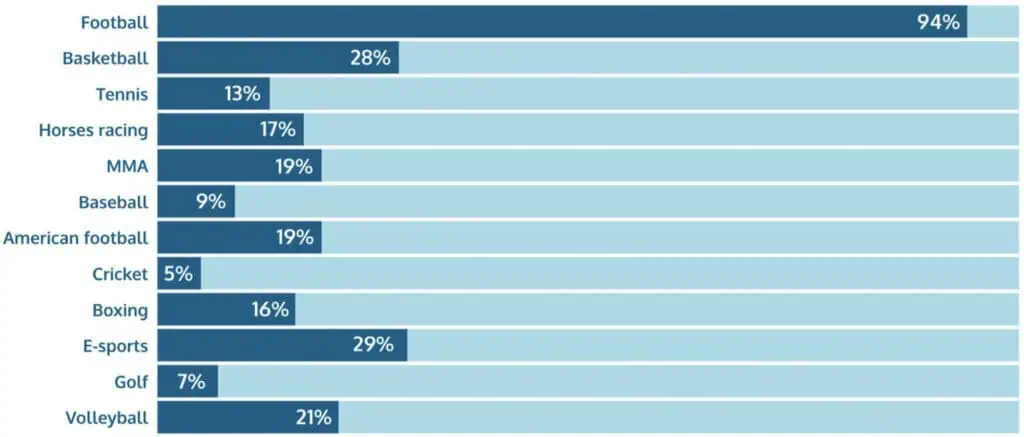
Source: ENV Media
It is therefore not surprising that in 2024, football accounted for 90.48% of the total volume of sports betting.
In Brazil, the top trends on Google tend to be for specific men’s football matches. Likewise, over the past 12 months, interest in football (blue) is significantly higher than in basketball (red), tennis (yellow), MMA (purple) and volleyball (green).
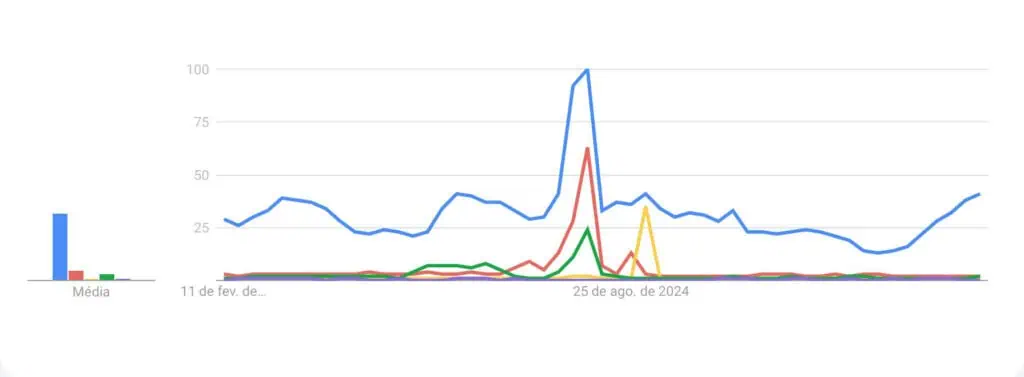
Source: Google Trends
Additionally, over the same period women’s football (blue, below) is also remarkably more searched for on Google than women’s basketball (red), women’s tennis (yellow), women’s MMA (purple) and women’s volleyball (green).

Source: Google Trends
Looking at the specific interest in the women’s divisions of sports bettors’ favorite categories, there is proportionally less search demand. However, the activity patterns are similar.
For both genders, despite consistent public interest, the spikes suggest a direct relation to top games and seasonal events. Not surprisingly therefore, the search volumes for women’s football peaked dramatically in August 4-10, 2024, when the Brazilian women’s national football team qualified for the finals of the Paris Olympics.
On August 6, Brazil defeated Spain and earned a spot in the final against the United States. At the finals held on August 10th, the US won and Brazil was the silver medalist, but solidified their competitive reputation.
The search volume chart for the keyword women’s football in Brazil from October 2020 to early 2025 confirms the relationship between increased interest and special events such as tournaments.
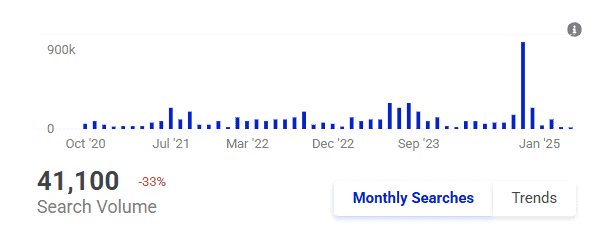
Source: Mangools
Therefore, we can infer that the spike in interest we detect in early 2025 is related to the January 17 announcement of the comeback of the Brazilian Women’s Football Cup, after it was suspended in 2016 by the Brazilian Football Confederation (CBF).
The professionalization of Brazilian women’s football
The Brazilian Women’s Football Championship, the country’s premier league, was only created by the CBF in 2013. In order to encourage national competition, it is divided into three different tiers – A1, A2 and A3.
One of the main clubs that have boosted the visibility of the league was Corinthians, who won 6 titles – 5 in a row including 2024.
Although challenges remain in terms of sponsorship, sustained media coverage and funding, the league has become a cornerstone in the professionalization of Brazilian women’s football.
The gender gap in Brazilian professional football
Naturally, the gender gap in Brazilian football is explained by historical gender inequality, which led to the ban on women’s participation in 1941.
In line with Brazilian society’s prejudices of the time, President Getúlio Vargas pronounced the sport “incompatible with female nature” and signed Decree No. 3.199 of April 14, 1941, which prohibited women from playing football.
According to the Senate Agency, any attempts to hold women’s games during the ban were either forcibly cancelled by the National Sports Council – CND – or shut down by the police.
As a result, Brazilian women were discouraged from improving their skills until 1979, when Getúlio’s Decree expired. Yet, women’s football was only regulated in 1983, near the end of the military dictatorship. By then, the Brazilian men’s national team had already won 3 FIFA World Cups in 1958, 1962 and 1970.
To further clarify the comparison with men’s football, the timeline below highlights the struggles and achievements in the history of Brazilian women’s football:


Caption: From Prohibition to Podiums – the Rise of Brazilian Women’s Football
Brazil was not the only country that banned women from playing football. In 1921, the English FA banned women’s matches on its grounds, citing “health concerns” – an excuse that Getúlio Vargas would also use. England repealed its ban, but only 50 years later, in 1971.
Germany had women’s play prohibited in 1955 and lifted its ban in 1970, followed by Sweden the same year and Norway in 1976.
Despite never banning women’s football, the United States would only invest in further professionalization by 1972, after the country passed Title IX, a federal law against gender discrimination in education programs funded by the state, which included sports.
As a result of the encouragement and investment, the US would win the FIFA Women’s World Cup in 1991, 1999, 2015 and 2019, as well as Olympic gold in 1996, 2004, 2008, 2012 and 2024.
Brazil Women’s Football National Team
Brazil has historically been one of the top nations competing at the highest level of women’s football:
- FIFA Women’s World Cup: Out of the 9 editions, Brazil finished as runner-up in 2007 and reached the semifinal in 1999. Additionally, it never failed to qualify for a FIFA Women’s World Cup since its first edition in 1991.
- Olympic Games: Brazil won 3 silver medals (2004, 2008, and 2024) and reached 37.5% of the finals in all 8 editions. Along with the US (75%), Sweden (37.5%), Germany (25%), Norway (25%) and Japan (25%), Brazil is one of the 6 nations out of 12 to have performed in more than one Olympic finals.
In December 2024, the Brazilian women’s national team reached the seventh place in the FIFA world rankings, climbing 4 positions from the previous year. Additionally, it has achieved absolute dominance in South America:
| Competition | Achievement | Year | Top Place % |
| Copa América Femenina | Champion | 1991, 1995, 1998, 2003, 2010, 2014, 2018, and 2022 | 88.89%. |
| Pan American Games | Gold | 2003, 2007, 2015, and 2019 | 80% |
| Gold Cup | Champion | 2024 | 100% |
In December 2024, Brazilian Marta Vieira da Silva was also the inaugural winner of the FIFA Marta Award, which was created in her honor. The prize is now awarded by FIFA for the most beautiful goal scored in women’s football during the year.
Thus, despite not winning neither the World Cup nor the Olympics, Brazil Women’s National Team have clearly consolidated their position at the top of the global stage.
What is more, these advances mark a major step in closing the sports gender gap in Brazil. Historically, women have often faced harassment in stadiums until their presence grew consistently, as sports commentator Luana Maluf recalled in a recent interview.
International transfers
International transfers are another key indicator of global reputation in any sport. In 2024, the countries with the highest rates of female players signed by foreign football clubs were the United States and Brazil.
According to the International Federation of Association Football (FIFA), out of 131 member countries – considering only the top 5 nations where women’s football is a professional sport – the current Olympic champions United States had the most international transfers of female footballers – 32.47% – followed by Brazil with 15.98%.
Of the 176 different nationalities represented among male footballers who signed international contracts, Brazilians were by far the largest group, with 35.33%. The more than 10,900 international transfers – an all-time record – represent spending over US$6.4 billion.
In contrast, Brazilian women reached a total of 2,284 international transfers. On a positive note, this marks a 20.8% increase from the 1,890 transfers in 2023. Additionally, spending on international transfer fees reached U$15.6 million, a notable increase (154.8%) over the U$6.1 million spent in the previous year.
Women’s football global fandom
Women’s football is increasingly appreciated worldwide and the 2023 FIFA Women’s World Cup set a new attendance record as a token of its popularity.
Around 2 million spectators attended the 64 matches, surpassing the 1.35 million who turned out for the 2015 World Cup in Canada by 48.15%. Compared to the inaugural tournament in China in 1991, which attracted a total of 500,000 spectators, the 2023 record represents a 300% increase in attendance.
To assess the global popularity of individual athletes, we compared the shares of the top 10 international players in terms of Instagram followers.
| Player | Affiliation | Share of followers in Top 10 |
| Alisha Lehmann | Forward for Juventus and Switzerland | 42.00% |
| Alex Morgan | Forward for San Diego Wave FC and the US. | 24.65% |
| Alexia Putellas | Captain and midfielder for FC Barcelona Femení and Spain. | 8.30% |
| Marta Vieira da Silva | Forward for the Orlando Pride of the NWSL and Brazil. | 7.04% |
| Sam Kerr | Forward for Chelsea FC Women and Australia. | 4.28% |
| Jordyn Huitema | Forward for OL Reign of the NWSL and Canada. | 3.52% |
| Asisat Oshoala | Forward for Bay FC and Nigeria. | 3.02% |
| Lieke Martens | Forward for Paris Saint-Germain Féminine and Netherlands. | 2.76% |
| Sakina Karchaoui | Left back for Paris Saint-Germain Féminin and France. | 2.43% |
| Ada Hegerberg | Forward for Olympique Lyonnais Féminin and Norway. | 2.00% |
Compared to the 2023 FIFA Women’s World Cup ranking, Brazilian forward Marta remains in fourth place with 7.04%, as well as Switzerland’s Alisha Lehmann, who still holds the first position with a staggering 42.00%.
The most noticeable difference is that Nigerian Asisat Oshoala climbed from eighth to seventh position with 3.02%, leaving Dutch Lieke Martens behind – 2.76%.
Overall, most athletes have not only maintained their Instagram following since 2023, but also increased it, as was the case of the Brazilian National Team.
Brazilian top scorers
As with the men’s competition, FIFA also rewards outstanding female athletes. Based on performance throughout the year, the FIFA The Best award goes to the top player. The only Brazilian to have achieved this award so far was forward Marta in 2007.
For its part, the top scorer in the World Cup is awarded with the Golden Boot. As to the share of goals among all the winners of the award, representing Brazil, both Marta and Sissi share the second position with 11.48%, along with Germany’s Birgit Prinz and China’s Sun Wen. With 16.39%, US Michelle Akers stands in first place.
Despite the hegemony of the US, Marta is a six-time FIFA World Player of the Year. The award, which is decided by votes from national team coaches, captains and journalists, assigns points based on ranking favourites.
| Year | Player & Country | Share of points in annual Top 3 |
2006 | Marta (Brazil) | 38.07% |
| Kristine Lilly (USA) | 31.08% | |
| Renate Lingor (Germany) | 24.45% | |
2007 | Marta (Brazil) | 57.92% |
| Birgit Prinz (Germany) | 29.72% | |
| Cristiane (Brazil) | 8.80% | |
2008 | Marta (Brazil) | 64.49% |
| Birgit Prinz (Germany) | 21.10% | |
| Cristiane (Brazil) | 17.71% | |
2009 | Marta (Brazil) | 56.56% |
| Birgit Prinz (Germany) | 19.69% | |
| Kelly Smith (England) | 17.12% | |
2010 | Marta (Brazil) | 38.20% |
| Birgit Prinz (Germany) | 15.18% | |
| Fatmire Bajramaj (Germany) | 9.96% | |
2018 | Marta (Brazil) | 14.73% |
| Dzsenifer Marozsán (Germany) | 12.86% | |
| Ada Hegerberg (Norway) | 12.60% |
Therefore, over these 6 years, Marta’s total share of the points awarded by all votes corresponds to an overwhelming 269.97%. In order to illustrate her dominance across the years she won the award, in second place is Germany’s Birgit Prinz with 85.69%.
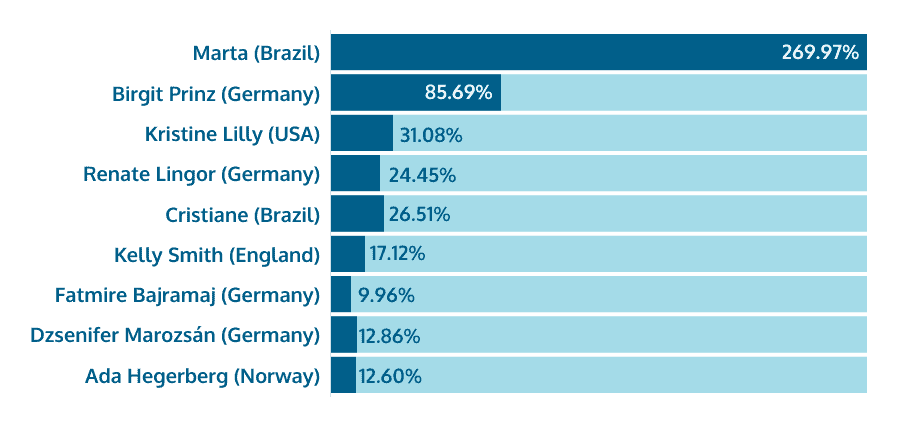
In fifth position with 26.51%, Flamengo’s Cristiane Rozeira increased Brazil’s total share to 296.48%. The country is followed by Germany – 139.79% – and the USA in third – 31.08%.
Looking at the 13 winners across all editions of the award, Marta still leads the rankings with 21.43%, followed by Birgit Prinz with about half her share – 10.71%.
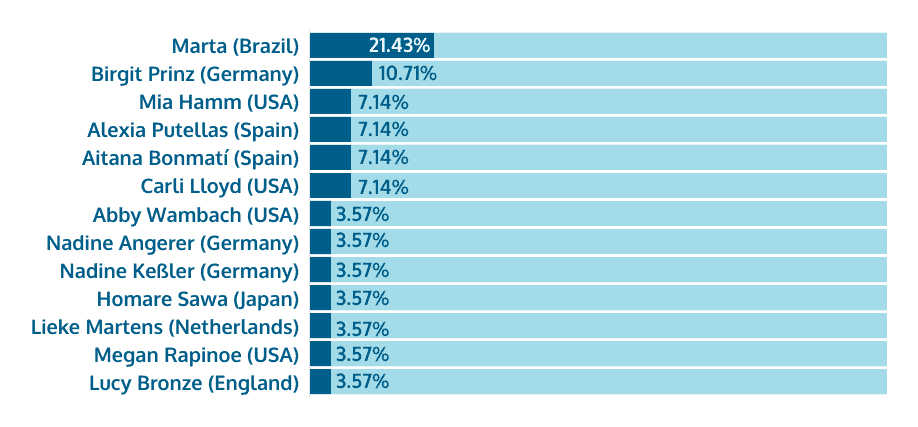
From the perspective of individual performance, it is therefore possible to estimate the total share per country. At the top of the list is Brazil with 21.43%, followed by the US with 21.42%.
Germany is third with 17.85%, followed by Spain with 14.28%. Japan, Netherlands and England share fifth place with 3.57% each.
2024 Brazilian Women´s Football Championship Top Scorers
If we look at last year’s (2024) Women´s Championship, we see Palmeira’s Amanda Gutierrez as the most prolific goalscorer in the division, followed by Corinthians’ Victória Albuquerque.
- Amanda Gutierres (Palmeiras): 15 goals.
- Victória Albuquerque (Corinthians): 13 goals.
- Cristiane Rozeira (Flamengo): 11 goals.
- Ariel (São Paulo): 7 goals.
- Duda Santos (Ferroviária): 7 goals.
- Cássia (Grêmio): 7 goals.
- Priscila (Internacional): 7 goals.
- Jheniffer (Corinthians): 7 goals.
Perhaps it is not a coincidence that the 3 Brazilian states where the leading women’s football clubs in the country are based – São Paulo, Rio Grande do Sul and Rio de Janeiro – are also among the top 5 states for female sports bettors, according to ENV Media. São Paulo has the largest share of female sports bettors (10.26%), followed by Bahia (8.49%) and Rio de Janeiro (4.94%). Goiás is next with 3.54%, while Rio Grande do Sul is fifth with 2.83%.
To assess the local popularity of the top 10 female football players, their relative share of Instagram followers is shown below.
- Cristiane Rozeira: 59.61%
- Victória Albuquerque: 14.78%
- Jheniffer Cordinali: 11.21%
- Priscila Silva: 5.68%
- Amanda Gutierres: 3.66%
- Duda Santos: 3.43%
- Ariel Godoi: 1.46%
- Cássia Moura: 0.31%
Despite ranking third in number of goals in the last edition of the national championship, Fifa World Cup veteran Cristiane is by far the most popular player on Instagram with 59.61% among the top 10. On the other hand, the top scorer Amanda Gutierres (15 goals), has “just” 3.66% of the followers in this ranking, attributable to an early stage in her career.
It is therefore only natural to conclude that the more a player wears the shirt of the national team, the more the general public is interested in them.
Nevertheless, the gap with the men’s game is still crushing. Neymar Jr. has 229 million followers, compared to Marta’s 2.8 million. Likewise, the women’s national team has 2.8 million followers compared to the men’s 17.6 million. Put differently, out of the total Brazilian national football team’s Instagram followers, women hold 13.73 %, while men hold 86.27 %.
Upcoming Women’s Football Tournaments
And yet, women’s football tournaments are becoming increasingly popular both in Brazil and abroad. The full calendar of competitions per year is described below:
2025
- Brazilian State Championships: January – March, Brazil.
- Brazilian Football Supercopa: February, Brazil.
- Brazilian Futsal Championship tier A: March – December, Brazil.
- Brazilian Women’s Football Cup: May – November, 2025, Brazil.
- UEFA Women’s Champions League 2024/2025: October, 2024 – May, 2025, Portugal.
- UEFA Women’s Euro 2025: July 2 – July 27, Switzerland.
- America Cup 2025: July 12 – August 2, Ecuador.
2026
- FIFA Women’s Club World Cup
2027
- FIFA Women’s World Cup – Brazil
To be announced:
- Libertadores Cup (CONMEBOL)
- Women’s Futsal World Cup: November – December, Philippines.
Therefore, attesting to the growing interest, not only will the CBF bring back the Brazilian Women’s Football Cup in 2025, but there will also be two new international tournaments: the FIFA Women’s Club World Cup and the Women’s Futsal World Cup.
Final Considerations
As things stand, the popularity of women’s football in Brazil is undeniable. With 76% of young Brazilians following the sport, and record attendances for key games (see 2024 Corinthians vs. São Paulo final), the movement is gaining wider recognition.
As we have shown by analysing Google searches, for both women’s and men’s football, spikes in interest are closely related to major events, such as Brazilian women winning silver at the 2024 Olympics.
In this sense, the comeback of the Brazilian Women’s Football Championship in 2025, together with the new FIFA Women’s Club World Cup, will provide opportunities for improving the visibility of women’s football at home and abroad.
The fact that women’s football was not regulated in Brazil until 1983 explains a lot about the gap to men’s football. When compared to the achievements and visibility of their male counterparts, women´s football still battles structural inequalities.
On the other hand, recent advances herald promising shifts, such as the 2019 CBF ruling that every club must have a women’s division, as well as Decree No. 11,458 from 2023 (see above).
Likewise, the growing importance of Brazilian women’s international transfers, second only to the US, indicates the consolidation of the global reputation of the country’s players. This is especially confirmed by the rise in spending on Brazilian female footballers´ international transfers.
Ultimately, despite the persistent gender gap in Brazil, the women’s game proves just as attractive and is gradually taking its place on the bigger stage.


